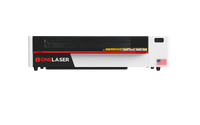Keeping your laser engraver in peak condition doesn’t have to be complicated. Whether you're new to the OneLaser X Series or a seasoned maker, proper laser engraver maintenance is essential for ensuring clean cuts, reliable performance, and a long machine lifespan.
In this guide, based on expert insights from Sean—Senior Engineer at OneLaser—you’ll learn six key components of your machine that require routine care.

From simple optics cleaning to laser alignment checks, this practical guide is packed with tips that apply to OneLaser’s XRF and XT models. Best of all, you’ll only need a few basic tools: rubbing alcohol, a rag, Q-tips, and optionally a shop vac.
Let’s dive into the six most important laser engraving machine maintenance tasks you should be doing every few months.
1. Why Laser Engraver Maintenance Matters
Neglecting basic upkeep can lead to:
- Misaligned beams and poor engraving quality
- Optics damage due to dust or debris
- Reduced airflow and increased fire risks
- Mechanical wear on your gantry system
Whether you own a CO2 laser or diode laser, routine maintenance ensures:
- Optimal beam quality
- Cleaner cuts and engraving
- Longer lifespan for parts
- Safer operation
2. Laser Alignment Check
Main Goal: Ensure the laser beam hits the same spot across the entire work bed.
Laser Alignment is one of the most critical maintenance checks. A misaligned laser can drastically affect your engraving quality and cut precision. The good news? You don’t always need a full calibration session—just a simple check will do most of the time.
Here’s how to do a quick tape test:
- Cover mirrors two and three with tape.
- Fire a single pulse at different positions across the bed.
- Inspect the burn marks. If they’re centered and consistent, your alignment is good.
- If they’re off, it’s time to do a full alignment.
Even though this test takes just a few minutes, it’s a powerful way to catch issues early and ensure consistent beam performance.
Frequency: Every 2–3 months
3. Optics Inspection (Mirrors & Lens)
Main Goal: Maintain beam strength and engraving clarity by cleaning your mirrors and lens.
Your laser’s mirrors and lens play a vital role in transmitting and focusing the laser beam. Over time, dust, smoke, and material residue can accumulate and block or scatter the laser.
Follow these steps:
- Pop open the laser head.
- Clean mirror #3 with a soft rag and alcohol or lens cleaner.
- You can clean it in place or remove it for deeper cleaning.
- Repeat the process for the lens.
- Check for grime, smudges, or discoloration that can affect performance.
Dirty optics will reduce power and engraving quality, so don’t skip this step.
Frequency: Every 1–2 months, more often with heavy use

4. Nozzle Cleaning
Main Goal: Keep the airflow clean and consistent for better cutting.
A clogged or dirty nozzle can disrupt airflow, reduce laser performance, and even lead to overheating or fires. Fortunately, cleaning it is fast and easy.
Steps to clean the nozzle:
- Use a rag with alcohol to wipe the exterior.
- For mild buildup, that’s often enough.
- If it’s heavily gunked, remove the nozzle and use a Q-tip to clean the inside.
- For deep cleaning, soak in warm water and dish soap, then rinse and dry.
Pro Tip: A clean nozzle also helps maintain proper air assist pressure during cuts.
Frequency: Every 1–2 months, or whenever you see residue buildup.

5. Rails & Gantry Motion System
Main Goal: Keep the X and Y-axis movement smooth and stable.
Over time, dust and material residue can collect on the rails and gantry system, affecting the precision of your laser’s motion. Fortunately, OneLaser’s X Series doesn’t require oiling—just regular cleaning.
To maintain the rails:
- Wipe the X and Y-axis rails with a dry rag.
- For stubborn dirt, use alcohol to lift debris.
- Do not apply oil or lubricant unless specified by the manufacturer.
Smooth motion translates directly to cleaner, more precise engraving. Ignoring this part can lead to jittery movement or skipping steps.
Frequency: Every 1–2 months, depending on usage

6. Exhaust Fan Maintenance
Main Goal: Ensure proper ventilation and avoid fire risks.
The exhaust fan is critical for removing smoke, debris, and fumes from your laser engraving area. A dusty, clogged fan not only reduces ventilation efficiency—it’s also a fire hazard.
Maintenance steps:
- Remove the fan cover if accessible.
- Wipe down the blades and housing using alcohol and a rag.
- Use a shop vac to remove dust if needed.
Neglecting your fan can lead to poor airflow, smoky workpieces, and potential damage to internal electronics.
Frequency: Every 2–3 months

7. Catch Tray Cleaning
Main Goal: Prevent debris buildup and reduce fire hazards.
Every laser engraving machine has a catch tray under the cutting bed to collect scrap material. Over time, this tray fills up with wood bits, acrylic dust, and other flammable particles.
To clean the catch tray:
- Slide out the tray from underneath the bed.
- Dump contents into the trash.
- Wipe down the tray with alcohol or sweep it clean.
- For deeper cleaning, use a scrub brush with mild detergent.
A dirty catch tray can lead to flare-ups, especially when cutting wood or acrylic. Keeping this area clear also ensures better air circulation under your project.
Frequency: Monthly or after heavy use

8. Bonus Tip for XT Users: Check Your Coolant Level
If you're using a OneLaser XT model, don’t forget to check the coolant tank in the back of the machine.
Steps:
- Open the back panel.
- Visually inspect the liquid level in the tank.
- Top it off if it's running low.
Coolant plays a critical role in keeping your laser tube temperature-stable, especially during long engraving sessions.
Think of it as a simple health check for your machine—it ensures it’s always ready when creativity strikes.

9. Essential Tools for Routine Maintenance
Here’s a quick checklist of what you’ll need:
- Rubbing alcohol or lens cleaner
- Soft microfiber rag
- Q-tips
- Screwdriver (for nozzle removal, if needed)
- Dish soap & hot water (for deep cleaning)
- Optional: shop vac for exhaust and debris
You don’t need a lot of fancy gear—just consistency and attention to detail.
Final Thoughts
Laser engraving is as much about precision and creativity as it is about care and maintenance. The OneLaser X Series are built to last, but like any high-performance machine, they thrive when treated right.
Set yourself a maintenance reminder every 1–2 months, and you’ll enjoy clean cuts, powerful performance, and fewer headaches down the line. Your future self (and your laser engraver) will thank you.
FAQs
Q: How often should I clean my laser engraver?
A: A light cleaning every 1–2 months is ideal, but increase frequency with heavier use.
Q: Do I need to use special lens cleaner?
A: Lens cleaner is ideal, but high-quality rubbing alcohol also works for general optics cleaning.
Q: Can poor maintenance affect engraving quality?
A: Absolutely. Dirty optics, misaligned beams, and clogged nozzles all impact engraving precision and consistency.
Q: Is this guide specific to OneLaser machines?
A: It’s based on OneLaser X Series machines, but many tips apply to other CO2 laser engravers as well.

 Liquid error (sections/image-banner line 171): invalid url input
Liquid error (sections/image-banner line 171): invalid url input




